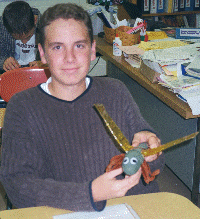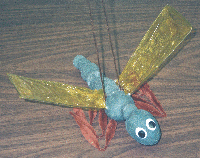I've got that Geometry Bug!
About Me
 I am a freshman in high school. I like sports, food,
and listening to music. Some of my favorite sports are football, baseball, and
indoor soccer. I like just about any kind of music, my favorite groups are
Blink 182, Ramstein, Limp Bizkit, and Ruff Ryderz. I also enjoy talking to
friends on the computer. My favorite subject in school is Honors Geometry.
I am a freshman in high school. I like sports, food,
and listening to music. Some of my favorite sports are football, baseball, and
indoor soccer. I like just about any kind of music, my favorite groups are
Blink 182, Ramstein, Limp Bizkit, and Ruff Ryderz. I also enjoy talking to
friends on the computer. My favorite subject in school is Honors Geometry.
Life as a Flygon
Have you ever heard of a Flygon? I hadn't
either until I made it up. Flygon is a bug that is based on geometry. It is
named flygon because he has some aspects of a dragonfly and the gon is because
he was made using geometrical shapes and ideas. Each part of the bug has a
certain purpose in the bugs lifestyle and where he lives. While building him I
kept in mind that it had to be made with geometric shapes and had to be
symmetrical. For the body I used spheres and an irregular oval shape. The body
of Flygon got smaller as it got further along the body sort of like a
dragonfly. To give the body texture and color I covered it with glue and then I
rolled the whole body in sand. For the wings I used a wire and made two
rectangles and made them roughly the same size. I used colored cellophane
shrink wrap to give the wings a realistic look. The eyes of Flygon are ovals.
For the legs I used a different type of pipe cleaner that gave the legs a
muscular look. Different parts of the legs have to be stronger than others. This
is because different legs have different purposes in the bugs life. I bent the
legs under some to give the illusion that it is flying. This is because, When
it is flying it tucks it's legs under it's body to make them more aerodynamic.
To allow it to hang from the ceiling I just put a hook above each wing and tied
a string to them. The color of the Flygon plays a big role in where it lives
and how it lives. Because of it's greenish-brown color it lives mainly in
wooded areas. This is because the brown helps it blend into the branches and
twigs. The green helps the Flygon blend in with the leaves and the vines that
grow on trees. Flygons are herbivores but they can and will attack other
organisms if provoked. Flygons are equipped with a stinger that contains poison
in it. The poison that is in the stinger will cause a severe rash, dizziness,
 dehydration, and vomiting. After stinging the victim
the Flygon does not lose it's stinger. They can sting as many times as they
need. Very rarely does a Flygon actually lose it's stinger. Each Flygon has a
life span of about one to two months. They can reproduce up to ten times during
their life. They build nests sort of like a bee hive. They use the same basic
structure as bees do but make some modifications of their own. Each hive is a
lot smaller than normal bee hives and only about 50 Flygons can live in a hive
at a time. After a Flygon has reached the age of about two weeks it leaves and
finds a mate and builds its own hive. Some of the offspring stay in the hive that
they were born in and find mates that are around there and their mates move in
and the old Flygons are forced to move out and find another place to live. A
lot of the Flygons don't live very long due to other organisms killing them or
dying in a fight with another Flygon over a mate or a place to live. But
overall Flygons are living like kings.
dehydration, and vomiting. After stinging the victim
the Flygon does not lose it's stinger. They can sting as many times as they
need. Very rarely does a Flygon actually lose it's stinger. Each Flygon has a
life span of about one to two months. They can reproduce up to ten times during
their life. They build nests sort of like a bee hive. They use the same basic
structure as bees do but make some modifications of their own. Each hive is a
lot smaller than normal bee hives and only about 50 Flygons can live in a hive
at a time. After a Flygon has reached the age of about two weeks it leaves and
finds a mate and builds its own hive. Some of the offspring stay in the hive that
they were born in and find mates that are around there and their mates move in
and the old Flygons are forced to move out and find another place to live. A
lot of the Flygons don't live very long due to other organisms killing them or
dying in a fight with another Flygon over a mate or a place to live. But
overall Flygons are living like kings.
My Favorite Links
Bloomington
High School
MTV
ESPN
Project
Description
Research Questions
Student Work
|